World Journal of Nuclear Science and Technology
Vol.2 No.4(2012), Article ID:23765,8 pages DOI:10.4236/wjnst.2012.24018
Correlations in Nuclear Interactions between ECM/u and Unexplained Experimental Observables
1Gesellschaft für Kernspektrometrie mbH, Ebsdorfergrund, Germany
2Fachbereich Chemie, Philipps-Universität Marburg, Marburg, Germany
3Institute of Nuclear Science, School of Physics, University of Sydney, Sydney, Australia
4Forschungszentrum Jülich GmbH, Jülich, Germany
5Fachbereich Materialwissenschaften, Technische Universität, Darmstadt, Germany
6Physics Department, Aristotle University of Thessaloniki, Thessaloniki, Hellas
7Joint Institute for Nuclear Research, Dubna, Russia
Email: *Westmeier@Westmeier.com
Received May 10, 2012; revised June 13, 2012; accepted June 24, 2012
Keywords: Thick Target; High Energy Projectile; Neutron Multiplicity; Mass Distribution
ABSTRACT
A new concept is introduced for the classification of “unresolved problems” in the understanding of interactions in thick targets irradiated with relativistic ions: The centre-of-mass energy per nucleon of a hypothetical compound nucleus from a primary interaction, ECM/u, is calculated and correlated with experimental observations in thick target irradiations. One observes in various reactions of relativistic primary ions with thick targets that there appears to be a threshold energy for reactions leading to “unresolved problems” which lies around ECM/u ~ 150 MeV. All “unresolved problems” are exclusively observed above this threshold, whereas below this threshold no “unresolved problems” are found. A similar threshold at 158 ± 3 MeV exists for massive pion production in nuclear interactions. Hagedorn had proposed this threshold decades ago and it is known as the Hagedorn limit. In this paper we will only mention, but not elaborate on Hagedorn’s theoretical concept any further. Some considerations will be presented and further studies in this field are suggested.
1. Introduction
Spallation mass-yield curves in nuclear interactions with thin targets were systematically studied in many nuclear chemistry laboratories for decades around the world. These observed spallation mass-yield curves strictly obey wellknown concepts of “limiting fragmentation” and “factorisation” (see section 2.2) and are thus well understood within current theoretical models. This applies for nuclear reaction studies induced by ions from Ekinetic < 1 GeV and is extending up to 80 GeV 40Ar irradiations. Limited studies extend up to proton induced reactions with Ekinetic = 300 GeV (see [1] for details).
Several articles have recently appeared describing “unresolved problems” in the study of nuclear interactions in thick targets induced by relativistic ions and their secondary reaction products [1,2]. Product yield distributions in thick copper targets from irradiations with 72 GeV 40Ar (at the LBNL, Berkeley), 44 GeV 12C (at the JINR, Dubna), and 48 GeV 4He (at CERN, Geneva) [3] cannot be understood with well-established theoretical concepts, thus constituting “unresolved problems”. Moreover, exceedingly large neutron emission during the irradiation of thick copper, lead and uranium targets with high energy heavy ion beams having Ekinetic > 30 GeV have been observed in several laboratories; where an exceedingly large neutron multiplicity is also considered to be an “unresolved problem”.
Several authors [4,5] confirm the existence of experimentally observed unresolved problems, however, they reject in very clear and strong terms any attempt to interpret these unresolved problems, even with unconventional approaches. Hartmann and Brandt have recently published one such unconventional approach [6].
All attempts to characterise unresolved problems in thick-target nuclear reactions since about 1954 [7] have borne no fruit; the problem being that there are no defined combinations of ion energy, projectile mass, and target mass where these unresolved problems systematically occur.
In this paper the following approach will be introduced:
One calculates on a purely hypothetical basis the centreof-mass energy ECM per nucleon in the entrance channel of the nuclear interaction. This entrance channel is defined by the kinetic energy EP of the primary ion (projecttile) with mass AP and the target mass AT. The value of ECM /u in units of MeV is calculated as:
 (1)
(1)
In thick targets experimentally observed phenomena are produced both by primary ions (primaries) up to the end of their range and in addition by secondary fragments (secondaries) making nuclear interactions in the thick target. The relative importance of nuclear reactions in thick targets due to secondaries compared to primaries increases with the thickness of the target [8]. One may correlate the value ECM/u—which might be taken as the hypothetical average excitation energy of each nucleon in the entrance channel of the reaction—with experimentally observed phenomena.
Some correlations are presented in Section 2 for increasing ECM/u. Obviously any observed correlation between ECM/u in the entrance channel and interactions of secondary fragments in thick targets will not explain the reason for unresolved problems. However, one does find a systematic dependence which allows a priori classification and selection of experiments where unresolved results are to be expected. In Section 3 we will present some considerations which may be helpful to understanding the observed order as presented in Section 2. Section 4 contains our conclusions on the subject and new experiments are suggested which may help to shed light onto this rather old and complex set of unresolved problems. In the Appendix few known and published experiments on thick targets irradiated with very highenergy ions having Ekinetic > 100 GeV will be reported.
2. Correlations between ECM/u and Unresolved Problems
Unresolved problems as discussed in detail in [1,2] are observed only in high energy nuclear interactions with thick targets. Three types of experiments which reveal unresolved problems are described in more detail below.
2.1. Production of 24Na in Two Copper Discs in Contact
The quantification of the isotope 24Na (T1/2 = 15 h) produced in a thick copper target consisting of two Cu-disks of 8 cm diameter and 1 cm thickness each in irradiations with relativistic ions requires just conventional gammaray spectrometry. Irradiations of two copper disks at various accelerators lasted only a few hours. After the irradiation, radioactive decay of 24Na was measured in order to calculate with an accuracy of about ±1% the activity ratio:
 (2)
(2)
where “upstream Cu” denotes the Cu-disk which is first hit by the beam and “downstream Cu” is the following Cu disk. There may be several downstream disks in a very thick target stack.
Correlations of ECM/u with experimental R0(24Na)- values are presented in Table 1 (column 3). In [1] it was shown that R0(24Na) > 1.0 constitutes an unresolved problem, i.e. one would normally expect more production of the very far spallation product 24Na in the first disk than in the second one. This case of an unresolved problem is systematically observed for ECM/u > 192 MeV as seen from the data presented in the third column of Table 1. The third column is divided into two sub-columns in which consistent and inconsistent (= unresolved) data are listed separately. R0(24Na) was not determined in reactions of 44 GeV 12C on Pb and U.
2.2. Maximum of Spallation Product Yields in Two Copper Discs in Contact
Similar to the activity ratio for the very distant spallation product 24Na, one can determine the yield ratio for any spallation product having nuclear charge Z and mass A as:
 (3)
(3)
Most product cross-sections that were measured some time after the end-of-bombardment are actually cumulative. One expects from the standard-model of nuclear reactions, based on the concept of “limiting fragmentation” and “factorisation”, that R0(A) distributions have a maximum value close to the mass of the target nucleus, i.e. close to A = 63 in a Cu target. The R0(A) distribution should then decrease continuously with decreasing product mass A, i.e. with increasing mass difference ΔA from the target mass. Detailed supporting arguments for this statement are given in [1,2], and in particular in [6].
An example of thin-target reactions induced by relativistic particles is shown in Figure 1 where mass distributions measured in thin copper targets that were irradiated with various projectiles are shown. The distributions of reaction products are characterised by the principles of “limited fragmentation” and “factorisation”. The term “limiting fragmentation” means that the shapes of spallation product mass distributions do not change between reaction systems and the term “factorisation” means that
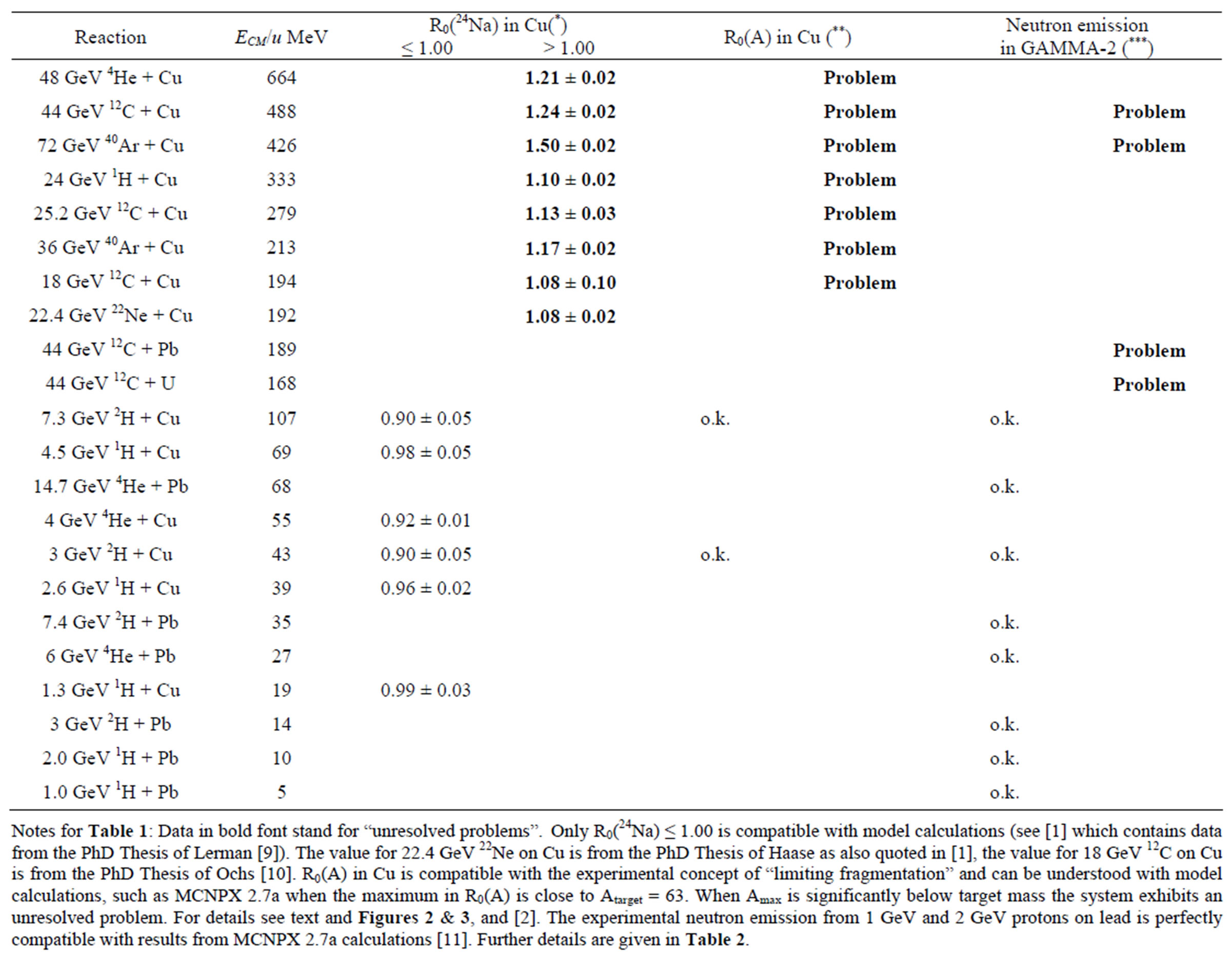
Table 1. Correlations in nuclear interactions between ECM/u and several observables.
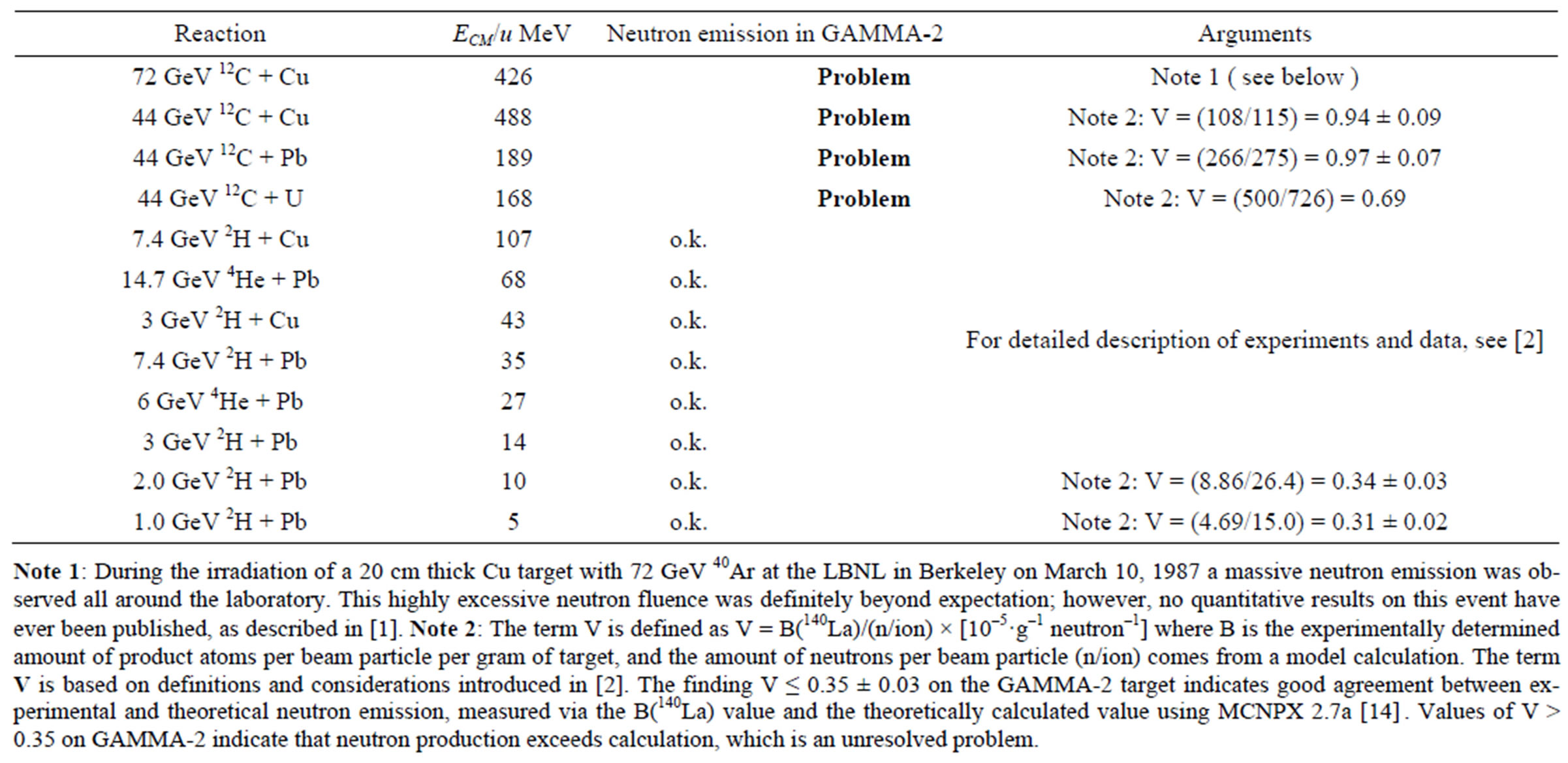
Table 2. Correlations in nuclear interactions between ECM/u and the observed neutron multiplicities on GAMMA-2.
the height (cross-section) of the distributions is simply dependent on the projectile mass.
For thick targets two figures shall clarify the situation of resolved vs. unresolved results: In Figure 2 the R0(A) distribution is shown for the reaction of 7.3 GeV 2H on a thick Cu target [10]. The maximum value of spallation product ratios is found around mass A = 57 from where on the distribution goes slowly down with rising ΔA, which is perfectly consistent with standard theoretical model results. On the other hand, the R0(A) distribution measured from interactions of 72 GeV 40Ar on a thick Cu target [12] shown in Figure 3 has its maximum around mass A = 51 which is far below the target mass and which cannot be reproduced by current models. In the former experiment (Figure 2) the cross-section ratio for the very distant spallation product 24Na is below unity (0.90 ± 0.05), whereas it exceeds unity (1.51 ± 0.02) in the latter experiment (Figure 3). The reaction system of Figure 2 is well resolved and in agreement with calculations, whereas the reaction system of Figure 3 is an unresolved problem.

Figure 1. Spallation mass distributions from interactions of various relativistic projectiles with a thin copper target. For details, see text.
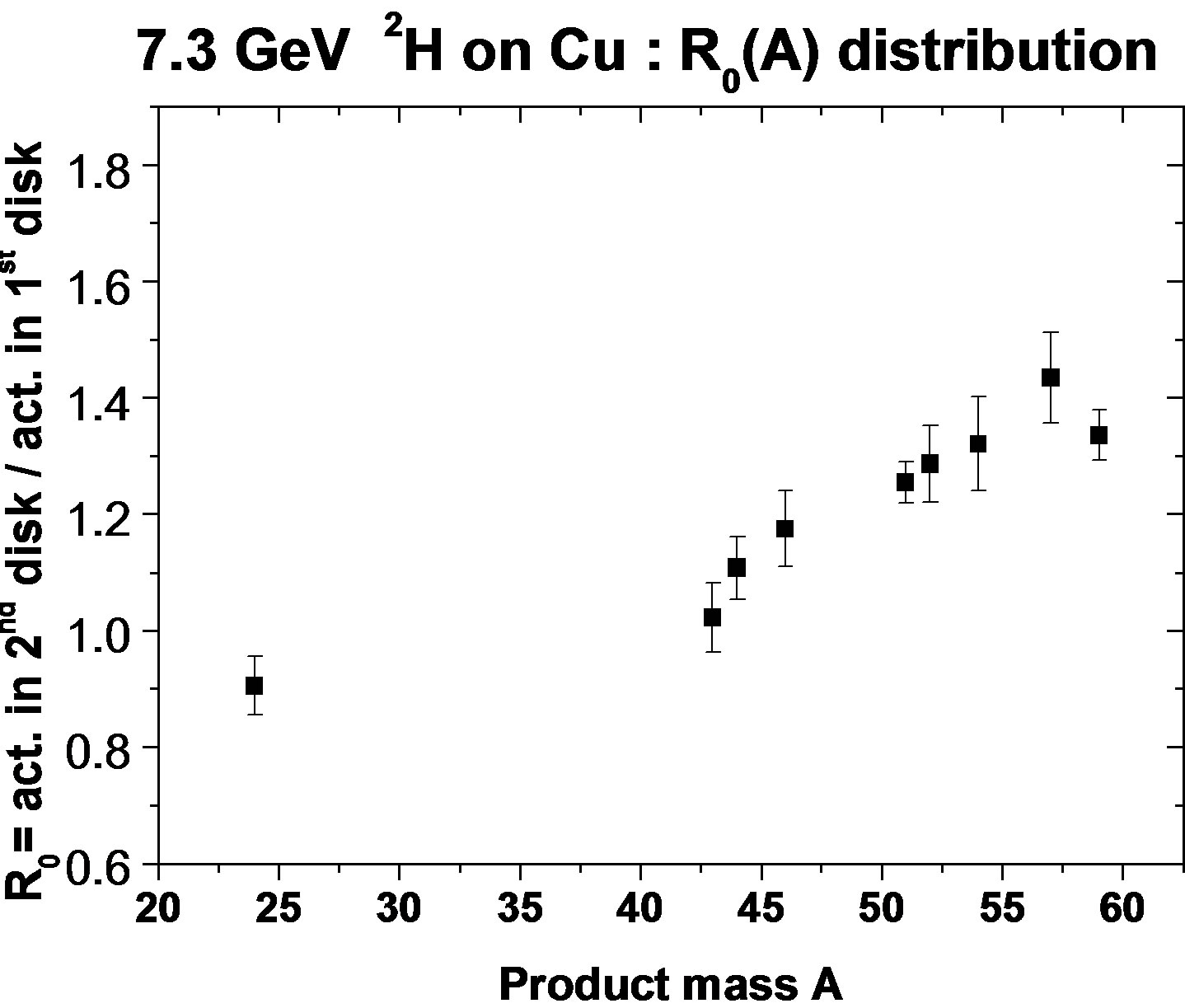
Figure 2. R0(A) distribution for the reaction of 7.3 GeV 2H on a thick two-disks Cu target. The maximum is around mass 57 which is consistent with model calculations and it constitutes NO unresolved problem.
Figure 4 gives slightly modified R(AZ) distributions from various projectiles hitting a 20 cm thick copper target, consisting of 20 disks of 1 cm thickness each. This Figure is taken from [1] and it is discussed in detail therein. Suffice it to say that the observed R(AZ) distributions for 44 GeV 12C and 18 GeV 12C constitute “unresolved problems” whereas the distributions for 7.3 GeV 2H and 3 GeV 2H indicate no problem, as Amax is close to the target mass. Identical conclusions derived from the distribution of 24Na throughout thick targets in the same reaction systems as shown in Figure 4 are drawn in [13].
2.3. Neutron Emission from “GAMMA-2” Target
The “GAMMA-2” target as described in several publications [e.g. 1, 3, 6, and 11] is a 20 cm long (thick) copper or lead spallation target, consisting of 20 metallic disks of 1 cm thickness and 8 cm diameter each. The metallic core is surrounded by a 6 cm thick paraffin moderator on all sides—with the exception of the front side, where the ion beam enters directly into the metallic target. The moderator surface contains small holes for plastic vials containing low-energy neutron (n, γ) sensors, for example

Figure 3. R0(A) distribution for the reaction of 72 GeV 40Ar on two 1-cm thick Cu-disks. The maximum is around mass 51 which is NOT consistent with model calculations and this distribution is an unresolved problem.
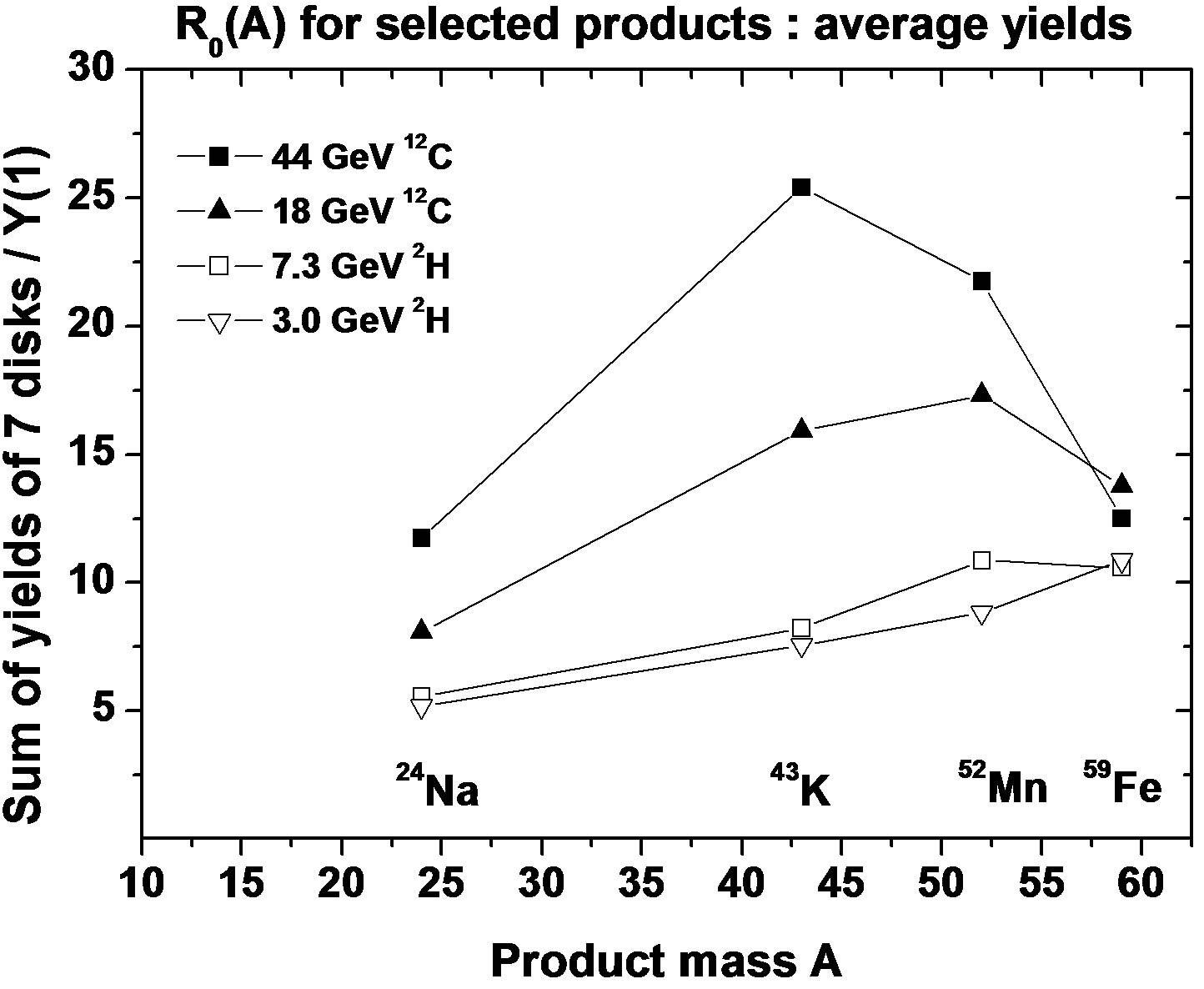
Figure 4. Yield ratio R0(A) for various masses A in a 20 cm thick Cu-target. Note the definition of R0(A) on the ordinate of this picture.
stable lanthanum salt. La-sensors measure directly the low-energy neutron fluence via the reaction 139La (n,γ) 140La. The radioactive decay of 140La is measured, thus allowing determination of the neutron production in the “GAMMA-2” target during irradiation. This target system and the integral data measured are an IAEA benchmark for transmutation since 2007. The target allows determination of the neutron production in the system during high energy irradiations, and simultaneous measurement of the spallation product yield distribution inside the metallic core. All experimental results are compared with modern computer simulations, for example using the MCNPX 2.7a code [14].
Results of comparisons between experiments on the GAMMA-2 target and model calculations are listed in Table 2. The agreement between experimental and calculated neutron yields is excellent for systems such as (2 GeV 2H + Pb) and (1 GeV 2H + Pb) [11]. No unresolved problems are encountered. However, one observes about a factor of 3 times more neutrons experimentally than calculated in reactions of 44 GeV 12C onto Cu, Pb, and U-targets [2]. This again constitutes another unresolved problem. These results are also included in the last column of Table 1. Again, it seems to be the same threshold ECM/u of primary interactions that separates resolved from unresolved thick target results.
In summary one can see in Tables 1 and 2:
All nuclear reactions—without any exception—having

are associated with “unresolved problems”, when their interactions are investigated in thick targets.
All nuclear reactions—without any exception—having

exhibit NO “unresolved problems”, when their interactions are investigated in thick targets. There is no problem with the latter class of nuclear interactions as theoretical model calculations agree with experimental findings. This is an important statement from a practical point-of-view. All low-energy nuclear interactions having practical relevance, such as in nuclear reactors or most accelerator applications are understood and modelled sufficiently well. They are not associated with any unresolved problem, especially with respect to excessive neutron production.
3. Tentative Interpretation of Observed Correlations
The essential result presented so far is the clear separation of unresolved experimental thick target results using the newly introduced ECM/u limit value. This limit separates results into two classes where those results from experiments below ~150 MeV agree with model calculations and those above this value are not reproduced by models. At present it is not clear to us why this is so, but it is interesting to note agreement with statements from Hagedorn who also considered an energy (or temperature T0) of 158 ± 3 MeV (“Hagedorn limit”) in a paper dating back to 1965 [15]. He pointed out that above this limit one should expect to produce pions easily (their rest mass is just below 150 MeV). Therefore there should be some kind of upper limit in nuclear temperatures that are allowed to exist in nucleonic matter. We will not pursue this line-of-thinking any further at this point.
A review of physics experiments studying nuclear interactions in thin targets and the emission of secondary elementary particles and projectile fragments was presented by Friedlander and Heckmann [16]. They describe a broad range of experimental techniques used and the data measured in these investigations. They report of no experimental result that lies outside the understanding in the frame of standard models—however, with the exception of certain nuclear emulsion studies, which are in fact thick target studies. In these studies some evidence for a “short mean-free-path” of projectile fragments was observed, called “anomalons” in those days. This evidence was observed for interactions of secondary fragments and they also have recently been considered [1] as unresolved problems.
We continue our considerations with the empirical approach to separate the FIRST nuclear interaction induced by the primary ion from SECOND nuclear interactions induced by secondary fragments in a thick target. Furthermore, we focus on the interactions of primary ions in nuclear interactions in thick targets above the critical limit of ECM/u ~ 150MeV which systematically show evidence of unresolved problems. Our interpretation of these phenomena suggests three hypothetical postulations, similar to the approach in [6]. However, our concept of interpretation is different.
1st postulation:
Small secondary fragments (probably mainly p, n, π0,+,-) may have properties that lead to reactions creating unresolved problems. In thin targets there is no possibility for secondaries to interact, whereas further reactions in thick targets expose the unresolved problems.
2nd postulation:
Secondary fragments created in a FIRST interaction with ECM/u > 150 MeV may have properties that change along their flight path.
How this change occurs is unclear at this stage, however, the fact that this change happens seems to be experimental fact, as will be shown below. We do not even know what the change is, but it could for example be a decay of the secondary fragment.
So far, there are few experiments known to the authors that show such a time-dependent change in nuclear properties without any external material interaction or particle emission within a time interval of 10−10 to 10−9 seconds. Evidence has been observed at the JINR in Dubna (Russia) in the irradiation of 20 Cu foils of 1 mm thickness each with 44 GeV 12C ions. The resulting Ri(24Na) yield distribution ratio is shown in Figure 5" target="_self"> Figure 5, taken from [17]. One observes almost constant Ri(24Na) values in the first foils which start to increase after about 5 mm target thickness and seem to reach equilibrium after about 15 mm. This may indicate that something “NEW” is entering into the experimentally observable physical reality.
The extension of results from Figure 5 is shown in Figure 6 where the production of 24Na by 44 GeV 12C in a stack of 20 Cu-disks of 1 cm thickness each is shown [17]. The absolute value of the activity ratio Ri measured for the 2 cm target slab in Figure 6 matches nicely the average of the 10 mm to 20 mm values from Figure 5, and then the ratio continues to increase up to about 10 cm target thickness. From there on the amount of product goes down as would be expected in a thick target where projectile density decreases through interactions.
3rd postulation:
The last postulation is a radical hypothesis.
When secondary fragments from an interaction in the ECM/u > 150 MeV regime interact with another target nucleus, the interaction cross-section and energy transfer is higher than that normally expected. This is the reason for the observation of shorter than expected mean free path and an enhanced neutron production as well as the concurrent enhanced production of very far spallation products.
Future experiments will determine whether this third postulation proves to be an acceptable or fruitful suggestion. More experiments and theoretical considerations are needed.

Figure 5. Yield ratio of 24Na in a stack of 20 foils (each 1 mm thick) of Cu irradiated with 44 GeV 12C at the Synchrophasotron in Dubna (Russia). The 24Na contents in each foil is measured (Yi) and compared to the 1st Cu foil (Y1). Some data points are averages of 2 foils.
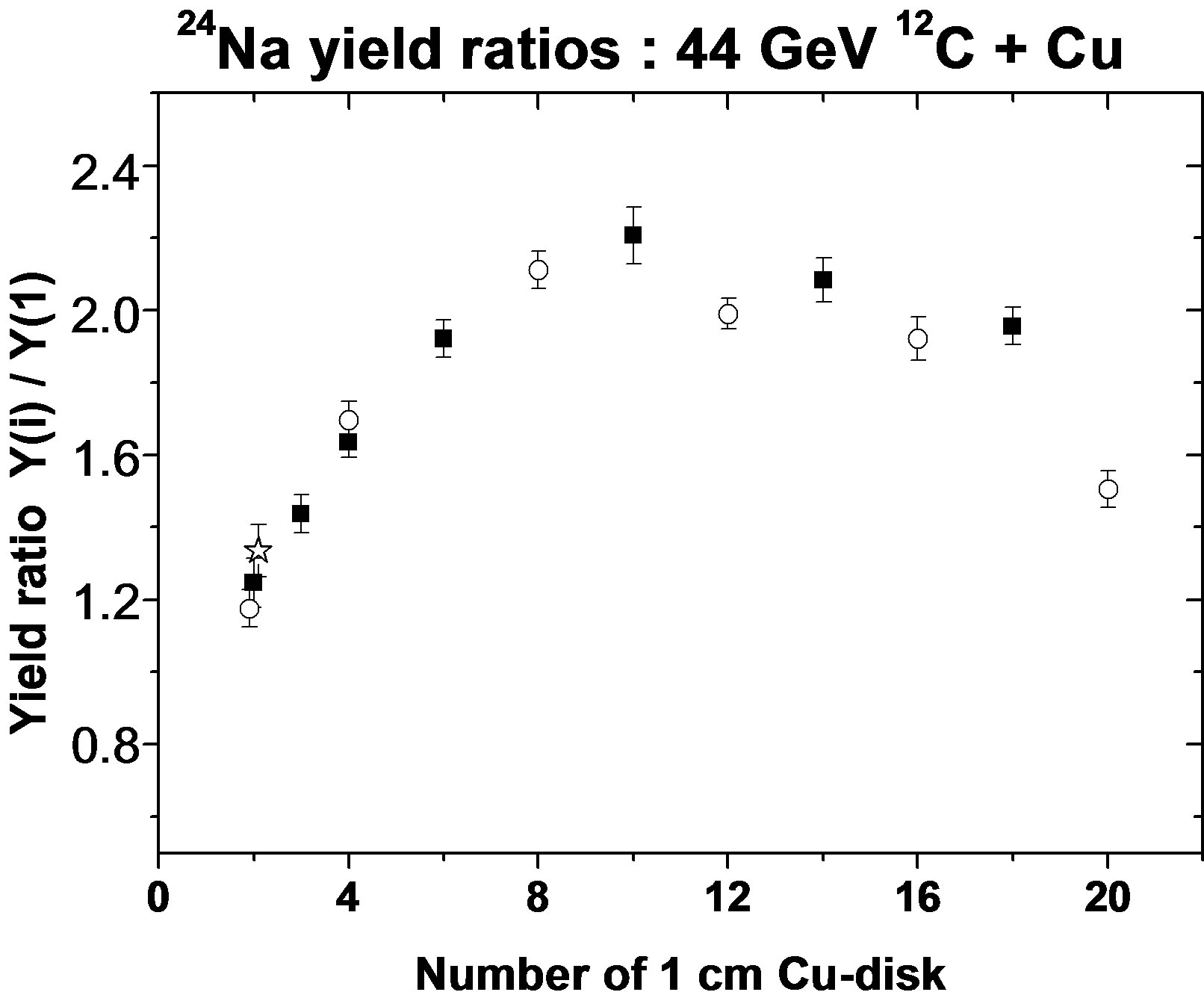
Figure 6. Yield ratio of 24Na in a stack of 20 Cu-disks of 1 cm thickness each irradiated with 44 GeV 12C at the Synchrophasotron in Dubna (Russia). Different symbols denote different experiments. The data point for the second disk plotted as a star is calculated from average values from Figure 5. Two data points for the second disk are displaced by 1 mm.
Some experiments that may provide additional information to this problem have already been published, and will be presented in the Appendix.
4. Conclusions
Various phenomena have been found in thick-target experiments induced by relativistic particles which are not in agreement with known reaction product systematics and cross-sections. These phenomena are found when projectiles of very high energies interact with the thick target or a stack of thin targets. The experimental results are divided into two groups according to their agreement or not with theoretical model calculations as well as conformity with results from thin-target experiments.
Phenomena are denoted as “resolved” when:
—the mass distribution of spallation products follows the principles of limiting fragmentation and factorisation as exemplified in Figure 1 and the cross-section of very far spallation products, such as 24Na, is largest in the beginning of the target;
—the measured neutron multiplicity is in agreement with model calculations;
—the mean free path of secondary particles follows known systematics.
On the other hand, phenomena are “unresolved” when
—the mass distribution of spallation products in a second (or following) interaction is skewed towards large ΔA and the cross-section of very far spallation products, such as 24Na, is significantly enhanced;
—the neutron multiplicity exceeds expectation values from model calculations, which seems to indicate a very high energy transfer in the interaction of a secondary fragment;
—the mean free path of secondary fragments is significantly shorter than known from range-energy systematics (see Appendix).
These experimental phenomena are produced in thick targets by primary ions up to the end of their path and by secondary fragments making additional nuclear interactions in the thick target.
A hypothetical description of the average centre-ofmass excitation energy of each nucleon (ECM/u) in the entrance channel of the reaction is correlated with experimentally observed phenomena. When we accept this concept of ECM/u of a hypothetical compound system as a means of classification, there seems to be a threshold value of ECM/u below which no unresolved phenomena at all are found in thick targets and all reaction product cross-sections are in agreement with model calculations, whereas reactions with energies above the threshold value, without any exception, lead to unresolved phenomena. However, due to scarcity of experimental results, the threshold energy is not very well defined. Results from all reactions having ECM/u ≤ 107 MeV show no unexpected results whereas the outcome of all reactions having ECM/u ≥ 168 MeV is clearly “unresolved”. We adopt the energy of ECM/u ~ 150 MeV as the threshold separating resolved from unresolved reaction systems. This value is close to another limiting energy (or limiting temperature T0) of 158 ± 3 MeV which was introduced through considerations of statistical thermodynamics by Hagedorn long ago and which marks the transition energy beyond which real hadrons are produced and “the number and longitudinal momentum of the secondaries produced would increase” [15].
In order to define the threshold energy more precisely, we wish to propose an experiment which scans over the limiting energy and will hopefully allow us to define it well. A simple and straightforward experiment is a thicktarget experiment employing three copper disks of 1 cm thickness each in contact, which are irradiated with a beam of 12C. Beam energies of 0.6 GeV/u (7.2 GeV kinetic energy), 0.9 GeV/u, 1.1 GeV/u, 1.2 GeV/u, 1.3 GeV/u, 1.5 GeV/u and 1.8 GeV/u are recommended. The experiments scan the kinetic energy range around 1.2 GeV/u which corresponds to ECM/u = 158 MeV for the 12C + 65Cu reaction. If the hypothetical average excitation energy around 150 MeV is actually a relevant limit, then R0(A) should indicate significant enhancement for masses A far away from the target mass, the 24Na cross Section ratio should go from below to above unity and the neutron dose-rate should rise over-proportionally (it is 3 times more than expected for 44 GeV 12C projectiles) when the threshold energy is exceeded. As interactions between nucleons inside a nucleus can be described by statistical thermodynamics, the limiting energy (or temperature) is not expected to be a sharp boundary but one rather expects to find a smooth onset of “unresolved” data around the limit value.
REFERENCES
- R. Brandt, V. A. Ditlov, K. K. Dwivedi, W. Ensinger, E. Ganssauge, S.-L. Guo, M. Haiduc, S. R. Hashemi-Nezhad, H. A. Khan, M. I. Krivopustov, R. Odoj, E. A. Pozharova, V. A. Smirnitzki, A. N. Sosnin, W. Westmeier and M. Zamani-Valasiadou, “Interactions of Relativistic Heavy Ions in Thick Heavy Element Targets—and Some Unresolved Problems,” Physics of Elementary Particles and Nuclei, Vol. 39, No. 2, 2008, pp. 507-526 (original), reprinted in Physics of Particles and Nuclei, Vol. 39, No. 2, pp. 259-285. doi:10.1016/j.radmeas.2008.03.060
- S. R. Hashemi-Nezhad, M. Zamani-Valasiadou, M. I. Krivopustov, R. Brandt, W. Ensinger, R. Odoj and W. Westmeier, “Neutron Production in Thick Targets Irradiated with High Energy Ions,” Physics Research International, Vol. 2011, 12 Pages, Article ID: 128429. doi:10.1155/2011/128429
- G. Dersch, “Kernchemische Studien zum Anomalonenphänomen bei Kernreaktionen mit Relativistischen Schwerionen,” PhD Dissertation, Philipps Universität, Marburg, 1986.
- P. B. Price, “Overview of a Conference (23rd International Conference on SSNTDs, Beijing, September 2006),” Radiation Measurements, Vol. 43, 2008, pp. 662- 664.
- R. C. Barber, H. Gäggeler, P. J. Karol, H. Nakahara, E. Vardaci and E. Vogt, “Discovery of the Element with Atomic Number 112 (IUPAP Technical Report),” Pure and Applied Chemistry, Vol. 81, No. 7, 2009, pp. 1331- 1343. doi:10.1351/PAC-REP-08-03-05
- I. Hartmann and R. Brandt, “Noise between ASAT and SAT,” In: Dr. P. Gschwind and B. Hugiweg, Eds., A Model for Nuclear Phenomena, Called Anomalons, Mathematisch-Physikalische Korrespondenz, Dornach, 2009, pp. 3-35.
- E. Rössle and E. Schopper, “Absorptionsanalyse der Sternauslösenden Komponenten der Ultrastrahlung,” Zeitschrift für Naturforschung Teil A, Vol. 9, 1954, pp. 837-851.
- S. R. Hashemi-Nezhad, R. Brandt, W. Westmeier, V. P. Bamblevski, M. I. Krivopustov, B. A. Kulakov, A. N. Sosnin, J.-S. Wan and R. Odoj, “Monte Carlo Analysis of Accelerator Driven Systems: Studies on Spallation Neutron Yield and Energy Gain,” Kerntechnik, Vol. 66, No. 1-2, 2001, pp. 47-53.
- L. Lerman, “On the Symmetry of Nuclear Identity between Relativistic Primary and Secondary Nuclei,” PhD Dissertation, Philipps-Universität, Marburg, 2002.
- M. Ochs, “Experimente zur Neutronenfreisetzung durch Spallationsreaktionen in Massiven Kupferund Bleitargets,” PhD Dissertation, Philipps-Universität, Marburg, 1997.
- W. Westmeier, et al., (in Preparation).
- K. Aleklett, R. Brandt, G. Dersch, G. Feige, E. M. Friedlander, E. Ganssauge, G. Haase, D. C. Hoffmann, J. Herrmann, B. Judek, W. Loveland, P. L. McGaughey, N. T. Porile, W. Schulz and G. T. Seaborg, “Unusual Behaviour of Projectile Fragments Produced by the Interactions of Relativistic Ar Ions with Copper,” Physical Review C, Vol. 38, 1988, pp. 1658-1673 and Erratum: Physical Review C, Vol. 44, No. 1, 1991, p. 566. doi:10.1103/PhysRevC.44.566
- M. Ochs, I. G. Abdullaev, J. Adam, J. C. Adloff, I. G. Bersina, V. Bradnova, R. Brandt, M. Bognitzki, V. S. Butsev, M. Debeauvais, K. K. Dwivedi, F. Fernandez, S.-L. Guo, M. I. Krivopustov, B. A. Kulakov, E.-J. Langrock, G. Modolo, R. Odoj, V. P. Perelygin, A. N. Premyshev, V. S. Pronskikh, Th. Schmidt, A. N. Sosnin, V. I. Stegailov, R. Sudowe, P. Vater, J.-S. Wan, M. Zamani and V. M. Tsoupko-Sitnikov, “SSNTD and Radiochemical Studies on the Transmutation of Nuclei Using Relativistic Ions,” Radiation Measurements, Vol. 28, No. 1-6, 1997, pp. 255-268. doi:10.1016/S1350-4487(97)00078-4
- D. B. Pelowitz, J. S. Hendricks, J. W. Durkee, M. R. James, M. L. Fensin, G. W. McKinney, S. G. Mashnik and L. S. Waters, “MXNPX 2.7A Extensions,” Report LA-UR-08-07182, Los Alamos National Laboratory, 2008.
- R. Hagedorn, “Statistical Thermodynamics of Strong Interactions at High Energies,” Supplemento Al Nuovo Cimento, Vol. III, 1965, pp. 147-186.
- E. M. Friedlander and H. H. Heckmann, “Relativistic Heavy Ion Collisions,” In: D. A Bromley, Ed., Heavy Ion Science, Plenum Press, New York, 1983.
- R. Brandt, G. Dersch, E. M. Friedlander, G. Haase, W. S. Butsev, M. I. Krivopustov, B. A. Kulakov, E. Ganssauge, W. Schulz, E. J. Langrock and F. Pille, “Untersuchung des Anormalen Verhaltens Relativistischer Fragmente aus Schwerionenreaktionen (Russian),” Isotopenpraxis, Vol. 25, 1989, pp. 433-438.
- R. Brandt, V. S. Butsev, H. H. Cui, G. Dersch, E. M. Friedlander, E. Ganssauge, G. Haase, M. Heck, M. I. Krivopustov, B. A. Kulakov, E.-J. Langrock and F. Pille, “Enhanced Production of 24Na by Wide-Angle Secondaries Produced in the Interaction of Relativistic Carbon Ions with Copper,” Physical Review C, Vol. 45, No. 3, 1992, pp. 1194-1208. doi:10.1103/PhysRevC.45.1194
- G. Alexander, R. H. W. Johnston and C. O’Ceallaigh, “The Relative Frequencies of the Decay Modes of Positive K-Mesons and the Decay Spectra of Modes Kµ3, τ’ and Kβ,” Physics and Astronomy, Vol. 6, No. 3, 1957, pp. 478-500. doi:10.1007/BF02781355
- E. Ganssauge, “Der Experimentelle Stand der AnomalonenForschung,” Annalen der Physik, 7, Folge, 11, 1987, pp. 202-246. and “The Experimental Status of the Anomalon Research,” Nuclear Tracks and Radiation Measurement, Vol. 15, No. 1-4, 1988, pp. 371-379. doi:10.1016/1359-0189(88)90169-0
Appendix
Experiments Using Thick Targets Irradiated with Ions Having Very Large Energy of Ekinetic > 100 GeV
Experimental results published from the study of thick targets irradiated with very high-energy ions above 100 GeV are scarce. We report only of a few experiments which appear to be significant and where unresolved problems may also play a role.
Evidence Based on the Radiochemical Cu-Disks Technique [18]
The Ri(24Na) ratios for several Cu disks in contact were determined for ions having up to 7000 GeV kinetic beam energy. No drastic or even surprising results have been reported. R0(24Na) for two Cu disks in contact in 7 TeV 32S irradiations was measured as R0(24Na) = (1.8 ± 0.1), not much larger than for 72 GeV 40Ar with R0(24Na) = (1.50 ± 0.02). It should be noted that both reactions fall into the same regime of ECM/u > 150 MeV and similar results may be expected.
Evidence Based on Reduced Mean Free Path
A strong difference in the mean-free-path of an elementary particle was observed in the very early days of investigations of high-energy nuclear reactions. Alexander et al. observed in 1957 [19] that π+-pions created in the decay of kaons [K+ → π+ + π0 ] (called “young” pions) have a mean free path of [Λ (young) = (11.0 ± 2.4) cm] in nuclear emulsion. However, conventional pions (called old pions) of the same momentum are known to have a mean free path of [Λ (old) = (31 ± 2) cm] in the same nuclear emulsion. Unfortunately, this crucial experiment has never been reproduced.
Similar evidence of reduced mean free path measured in nuclear emulsion was published by Friedlander and others, as reviewed by Ganssauge [20], for reactions induced by projectiles with kinetic energies up to 100 GeV.
In summary, one needs further experiments and new concepts in this field in order to have sufficient understanding of the underlying physics of reactions induced by secondary fragments.
NOTES
*Corresponding author.

